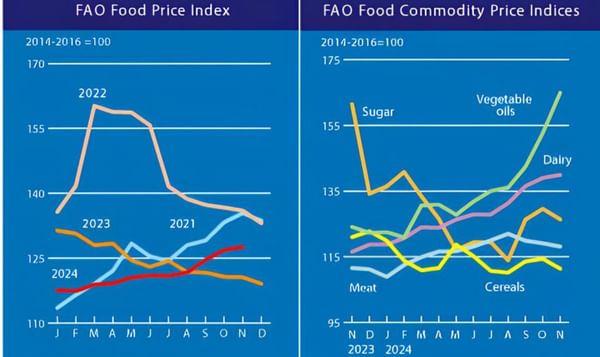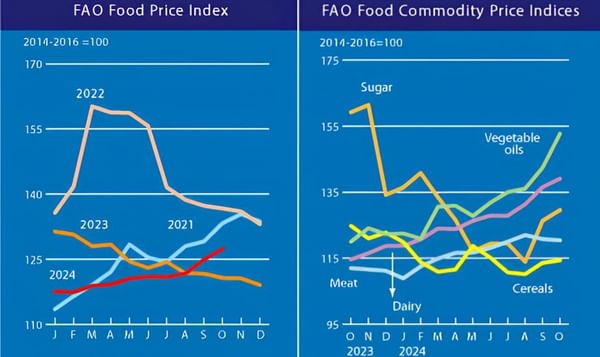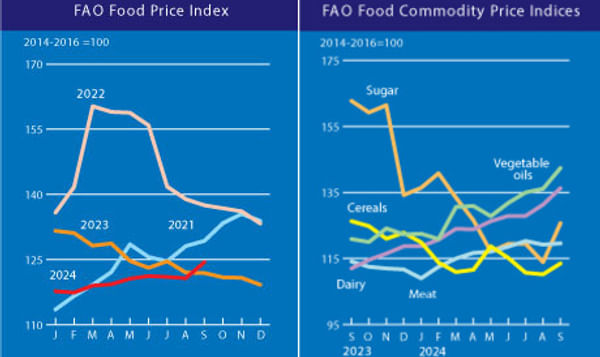The FAO Food Price Index (FFPI) averaged 175.8 points in November 2017, down fractionally (0.5 percent) from October but still almost 4 points (2.3 percent) above the corresponding period last year.
FAO Food Price Index down slightly in November

The FAO Food Price Index (FFPI) averaged 175.8 points in November 2017, down fractionally (0.5 percent) from October but still almost 4 points (2.3 percent) above the corresponding period last year. A sharp rise in sugar and vegetable oil quotations was largely offset by a fall in dairy values while international prices of cereals and meat products remained relatively muted.
The FAO Cereal Price Index averaged 153.1 points in November, nearly unchanged from October but up almost 12 points (8.3 percent) from November 2016. The Index has remained largely steady since August, generally reflecting an overall balanced supply and demand situation especially with regard to wheat and maize markets. In November, international rice prices rose by 1.1 percent, amid stronger buying interest and currency movements.
The FAO Vegetable Oil Price Index averaged 172.2 points in November, up 2.1 points (or 1.2 percent) from October and marking a 9-month high. The rise mainly reflects higher quotations for soy, rapeseed and sunflower oils. Soy oil quotations increased, as weather uncertainties continued to affect crops in South America and also because below-average oil content was reported for the United States’ recently harvested crop. International prices of sunflower and rapeseed oils rose, underpinned by, respectively, subdued availabilities and firm demand. Lower palm oil values, mainly following a hike in Indian import duties and higher than anticipated closing stock levels in Malaysia, prevented the index from rising further. Firm mineral oil values also lent support to vegetable oils prices.
The FAO Dairy Price Index averaged 204.2 points in November, down 10.6 points (4.9 percent) from October, representing the second consecutive month of a sharp decline. However, the index is still 9.6 percent higher than November 2016. International price quotations for butter, cheese and whole milk powder (WMP) all fell, as rising milk output in all the major producing countries contributed to reducing concerns about the availability of supplies. Skim milk powder (SMP) prices slid to a near 18-month low, on continued uncertainty over the intervention stocks held by the European Union.
The FAO Meat Price Index averaged 173.2 points in November, almost unchanged from its slightly revised October value. International price quotations for pigmeat weakened for the third consecutive month, on account of slow import demand and large export availabilities. Similarly, ovine meat quotations slid downward, for the second successive month, largely due to continued increase in meat supplies in Oceania. By contrast, bovine meat prices rose for the third month in a row, supported by limited spot supplies from Oceania. Prices in poultry meat markets remained stable.
The FAO Sugar Price Index averaged 212.7 points in November, up 9.2 points (4.5 percent) from October but still as much as 26 percent below the corresponding month last year. International sugar prices rose in November, mostly supported by a drop in exports from Brazil and concerns over firmer oil prices encouraging greater switch of cane crush to produce ethanol than sugar.
The FAO Cereal Price Index averaged 153.1 points in November, nearly unchanged from October but up almost 12 points (8.3 percent) from November 2016. The Index has remained largely steady since August, generally reflecting an overall balanced supply and demand situation especially with regard to wheat and maize markets. In November, international rice prices rose by 1.1 percent, amid stronger buying interest and currency movements.
The FAO Vegetable Oil Price Index averaged 172.2 points in November, up 2.1 points (or 1.2 percent) from October and marking a 9-month high. The rise mainly reflects higher quotations for soy, rapeseed and sunflower oils. Soy oil quotations increased, as weather uncertainties continued to affect crops in South America and also because below-average oil content was reported for the United States’ recently harvested crop. International prices of sunflower and rapeseed oils rose, underpinned by, respectively, subdued availabilities and firm demand. Lower palm oil values, mainly following a hike in Indian import duties and higher than anticipated closing stock levels in Malaysia, prevented the index from rising further. Firm mineral oil values also lent support to vegetable oils prices.
The FAO Dairy Price Index averaged 204.2 points in November, down 10.6 points (4.9 percent) from October, representing the second consecutive month of a sharp decline. However, the index is still 9.6 percent higher than November 2016. International price quotations for butter, cheese and whole milk powder (WMP) all fell, as rising milk output in all the major producing countries contributed to reducing concerns about the availability of supplies. Skim milk powder (SMP) prices slid to a near 18-month low, on continued uncertainty over the intervention stocks held by the European Union.
The FAO Meat Price Index averaged 173.2 points in November, almost unchanged from its slightly revised October value. International price quotations for pigmeat weakened for the third consecutive month, on account of slow import demand and large export availabilities. Similarly, ovine meat quotations slid downward, for the second successive month, largely due to continued increase in meat supplies in Oceania. By contrast, bovine meat prices rose for the third month in a row, supported by limited spot supplies from Oceania. Prices in poultry meat markets remained stable.
The FAO Sugar Price Index averaged 212.7 points in November, up 9.2 points (4.5 percent) from October but still as much as 26 percent below the corresponding month last year. International sugar prices rose in November, mostly supported by a drop in exports from Brazil and concerns over firmer oil prices encouraging greater switch of cane crush to produce ethanol than sugar.
Like to receive news like this by email? Join and Subscribe!
Join Our Telegram Channel for regular updates!
精选企业
Sponsored Content
Sponsored Content
Sponsored Content
Sponsored Content
Sponsored Content











